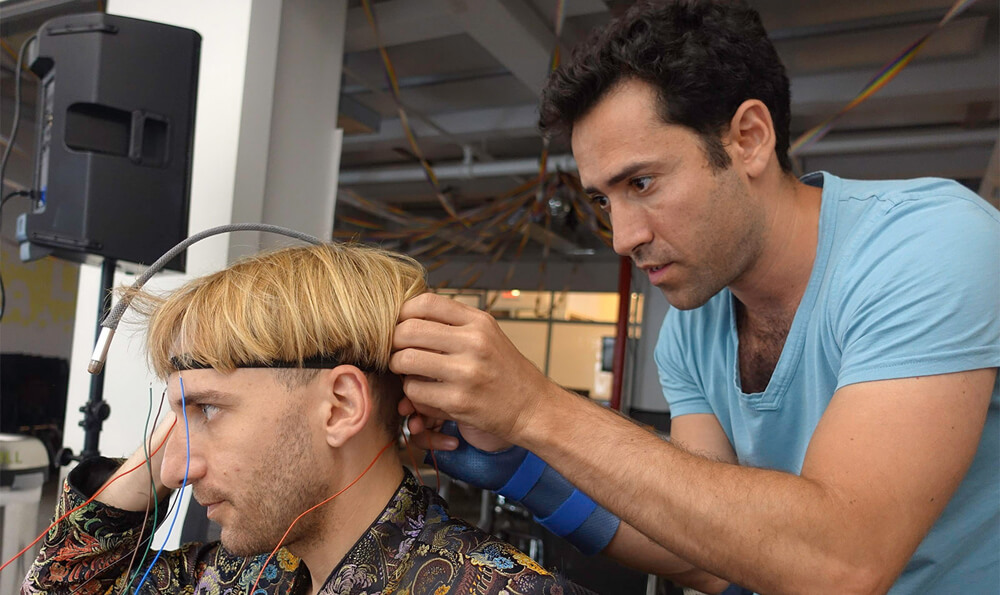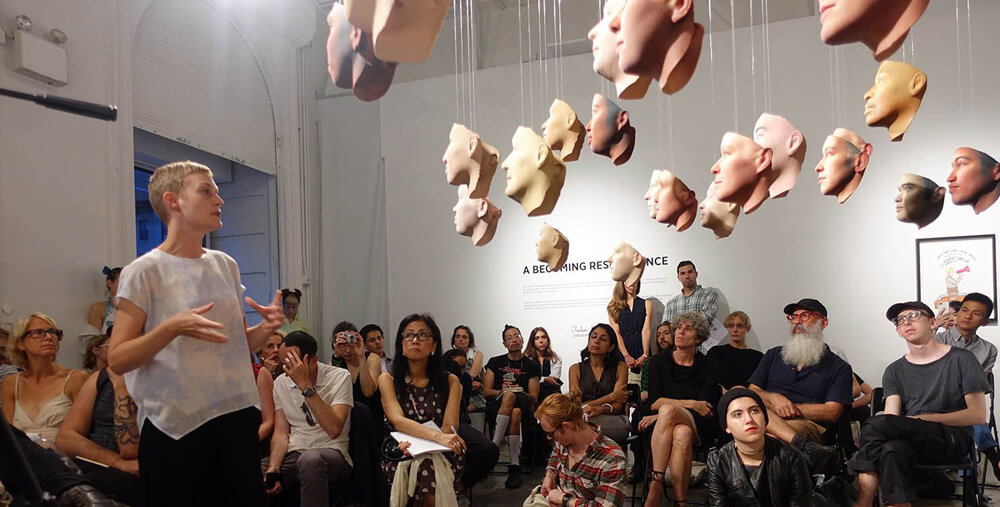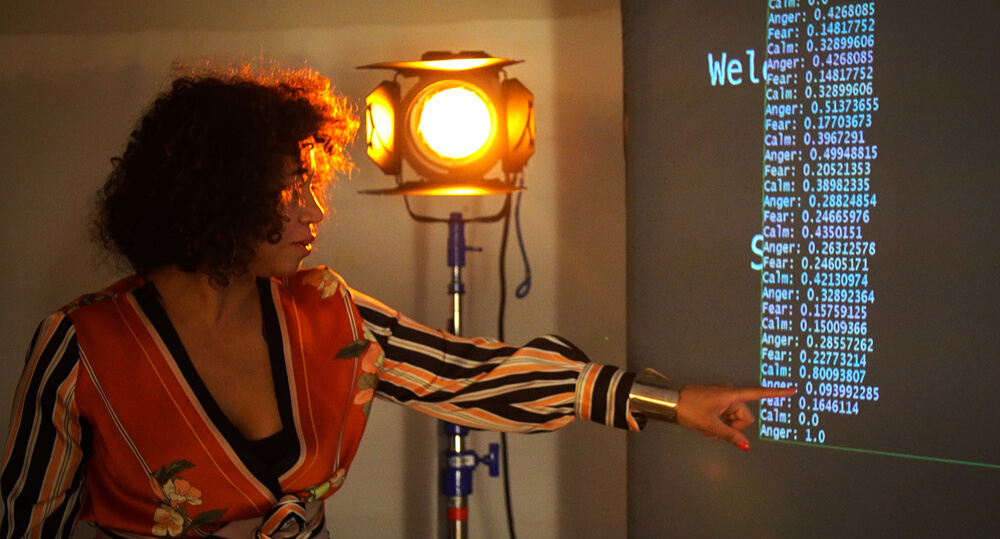Interview by Ashley Lee Wong

ThoughtWorks in New York has created an ambitious arts residency selecting artists to engage with socially relevant projects using emerging technologies. They also sponsor Art-A-Hack™ art and technology team collaborations, as well as weekly Hardware Hack Labs, by using the corporate resources of a multinational tech consultancy.
Founded by Andrew McWilliams, a New York-based British software engineer and Lead Technologist at ThoughtWorks, whose art practice deals with issues linking personal health and climate change. Ellen Pearlman received her PhD at the School of Creative Media, City University of Hong Kong. She is a new media artist, curator, writer and critic, and Fulbright World Learning Specialist, whose artistic practice centered on brain-computer interfaces and artificial intelligence.
Together the two have created a unique platform for research and production of socially engaged projects with art and technology. Having followed the ThoughtWorks Arts Residency since its inception in 2016, I had the chance to speak with both of them about their work and the achievements and challenges of bringing artists into the world of tech.
Over two years since the residency has been established, they have supported artists-in-residence, including the Cyborg Foundation (Neil Harbisson and Moon Ribas), Heather Dewey-Haborg, Karen Palmer, Hannes Bend, Adrianne Wortzel, and Catie Cuan. They have also incubated an open-source AI system for emotion detection, cyborg “sensory organs”, a comic illustration about genetic data privacy centred around the former political prisoner Chelsea Manning, and a biometric system for virtual reality.
Not many people, particularly in the art world, may have heard of ThoughtWorks. Unlike many other well-known tech companies, ThoughtWorks is a client-facing company that rarely promotes its work directly to the public. To give some background, ThoughtWorks is a global software and digital transformation consultancy originally founded in 1993 in Chicago.
As a leading software company, they have over 5,000 employees spread across 41 offices in 14 countries. The company prides itself on three pillars 1) Sustainable Business, 2) Software Excellence and 3) Social Justice, a concept written by their Chief Scientist, Martin Fowler1. As a company with a strong sense of values, they support development from the ground up by employing Agile and open source methodologies.
Their support for the arts is central to the company’s culture, enabling them to interface with progressive individuals and organisations and allowing employees to develop new skills and understanding of technological changes and their social implications. The arts align with their values in technical excellence and positive social impact in the world that benefits artists and their social agendas, but also the company at large.
1 https://martinfowler.com/bliki/ThreePillars.html


How did you start the ThoughtWorks Arts Residency? How did the idea evolve?
Andrew McWilliams: I joined ThoughtWorks after several years as a practising artist, applying my software engineering background as an artistic medium. It is a unique place to work, and I was able to get involved with both commercial and “social impact” projects within the company. I began to realize there was a mutual overlap in our interests and perspective with the larger technology arts world. Both communities are deeply investigative and have long been aware of the social and cultural impacts of technology. Before creating the residency program, Ellen and I collaborated on Art-A-Hack™2, demonstrating the possibilities and setting the stage for a deeper and sustained version of a commercially-supported incubation program.
Ellen Pearlman: We were already running Art-A-Hack™, a practice-based rapid prototyping art and technology collaboration that usually takes place over four Saturdays when we realized that we needed to create something that was much more in-depth. There are many pressing issues in art and tech that we felt could be more deeply investigated through a longer-term residency. Having done many art residencies myself, I knew how valuable they are for an artist’s practice.
2 https://artahack.io/about/
What kind of support do artists receive from ThoughtWorks for the residency?
Ellen Pearlman: Artists receive between $6,000 and $11,000 for approximately sixteen weeks, depending on if it’s a dual or single residency. Also, they are allowed to stay on without monetary support for a few weeks after that to wrap up the project.
Residents come into the ThoughtWorks office on Madison Avenue. They can work there if they choose and are able to discuss their project with any interested parties – to treat it as an office of their own. Depending on the project, they will get loaned studio space, such as with the robotics residency, but usually, they don’t need actual studio space. The workspace is adequate. Andrew and I both mentor the artists. Andrew offers more on the technical side, and I offer critiques, suggestions and additional resources. Andrew also coordinates the in-house ThoughtWorks programmers, designers and specialists.
Andrew McWilliams: Artists are provided with a stipend, which equates to a living wage. We adjust it to the specifics of each residency but usually works out to around $2,800 a month, plus additional equipment costs.
Artists use the office space at ThoughtWorks, which is regularly frequented by our employees and other external partners whose research, technology or social impact projects we are incubating. Our offices host frequent public events, often hosted by friends, partners and allies, and there are considerable networking opportunities available just by working from our office.
Residents are provided facilitated access to the global network of technology professionals across ThoughtWorks globally. This includes designers, developers, analysts, data scientists and a host of other experts in various disciplines. These collaborators work with residents toward achieving their project ambitions, and sometimes this work leads to spin-off projects, as was the case with Angelica Perez’s development of the EmoPy toolkit3, which was initiated during Karen Palmer’s residency in 20184.
We provide promotional opportunities, such as our inclusion in exhibitions like SPRING/BREAK as part of Armory Week5 or speaking slots at conferences such as Xconf6 and Paradigm Shift7. These offer great exposure and access to new audiences.
3 https://github.com/thoughtworksarts/EmoPy
4 https://thoughtworksarts.io/projects/riot/
5 https://thoughtworksarts.io/spring-break/
6 https://www.thoughtworks.com/xconf-na/content
7 https://www.thoughtworks.com/paradigmshift
Could you tell us about some of the artists-in-residence and what they produced?
Andrew McWilliams: Our first artists were the Cyborg Foundation8, the duo consisting of artists Neil Harbisson and Moon Ribas from Barcelona. They explored the creation of new forms of technology-based sensory organs as permanent human implants. We helped them investigate two new senses – the “Time Sense”9 and the “Seismic Sense”10.
The theme of the first residency was investigating trans-humanism and the future of bodily augmentation. There is an ongoing movement towards the convergence of biological and digital matter, with profound potential implications for society. The residency supports artists investigating the impact of emerging technologies on society, and working with the Cyborg Foundation helped us establish that principle, as something we could work forwards curatorially from there.
Ellen Pearlman: Both artists are living cyborgs, in that they have implants in their body that function 24/7. They wanted to enhance their implants. Neil wanted to create a sense of time through heat that moved through a silicon headband that he would eventually implant, and Moon worked on expanding her use of earthquake sensors into her feet, instead of just her arm, where one was already located, to create her dance choreography. Neil has yet to implant the headband, but Moon went ahead after the residency ended and implanted new sensors into her feet. We had nothing to do with the actual surgical implantation.
Andrew McWilliams: Heather Dewey-Hagborg joined the residency at around the time of the 2016 election, intending to explore the black market for the sale and resale of genetic information online. The US election results completely transformed her project mid-flow. There was increasing press speculation that the incarcerated whistleblower Chelsea Manning, with whom Heather had previously collaborated, had a short window of time before which a presidential pardon would become all but impossible. Heather worked with Chelsea and a ThoughtWorks illustrator in India named Shoili Kanungo to create Suppressed Images, a comic highlighting the genetic data themes behind Heather and Chelsea’s collaboration11. The final pane of the comic speculated that Obama would pardon Manning, leading to an art exhibition, which Chelsea would attend. Shortly after the publication of the comic, the entire story spectacularly came true.
Ellen Pearlman: We made up an imaginary ending that Chelsea was pardoned and was able to attend one of Heather’s art openings that featured Chelsea’s images. On the day we published the comic book, which was January 17, 2017, Obama shockingly enough freed Chelsea. That summer, Chelsea also attended an opening of Heather’s show featuring both the comic book and 100 different mask interpretations of her DNA. We were pretty thrilled about that! Another resident, Hannes Bend, worked on a project with biometrics, meaning the breath inside a VR meditation application. Karen Palmer refined her video installation RIOT12, which used facial expression analysis algorithms to change the plot of a film of a riot live time, meaning depending on the viewer’s emotional reaction, the film switches to different scenarios. What was really interesting about that project was the team was re-writing the machine learning facial analysis algorithms from the ground up and open-sourcing them13.
8 https://thoughtworksarts.io/blog/introducing-cyborg-foundation/
9 https://thoughtworksarts.io/projects/time-sense/
10 https://thoughtworksarts.io/projects/seismic-sense/
11 https://suppressedimages.net/
12 https://thoughtworksarts.io/projects/riot/
13 https://github.com/thoughtworksarts/EmoPy
Could you tell us a bit about the latest artist-in-residence for 2018 and their projects?
Ellen Pearlman: Catie Cuan and Adrianne Wortzel are our dual robotics residents14. In a sense, they are absolute opposites. Catie is a millennial, a dancer with the Metropolitan Opera Ballet, and very precise and crisp. Adrianne has been working with robots for decades, started an arts and tech program at one of the New York City colleges, and makes whimsical, almost comedic pieces about robots. She is all over the place, and her mind hops around a lot, quite the opposite of Catie. Catie is exploring the uncanny valley, meaning the point where humans believe in and interact with robots, and Adrianne hates the uncanny valley.
We were extremely fortunate to discover in New York City the Consortium for Research and Robotics, an extended partner of Pratt Institute located at the Brooklyn Navy Yard. They have a number of robots, including a 15-foot ABB Robotics industrial robot arm. They agreed to work with our residents and support them in the creation of new work. Catie will be choreographing a piece, as well as filming it with the ABB, and Adrianne will be making a sort of old-time silent movie piece between the ABB, and a much smaller, crab-like gaming robot called the Mekamon15.
14 https://thoughtworksarts.io/blog/adrianne-wortzel-catie-cuan-awarded-robotics-residency/
15 https://thoughtworksarts.io/blog/robotics-artists-begin-residencies/
How did you select the themes for the residencies?
Andrew McWilliams: The themes are created in conversation between Ellen and myself and our network of partners. We have previously exchanged with organizations like AI Now16, the Consortium for Research and Robotics17, Baltan Labs18, and many others, to help guide our thinking about how to approach a given subject.
Ellen Pearlman: I read deeply and widely, and this is an area where my PhD is useful as I drill down into very complex issues that are co-emerging in the art and tech scene. I present them to Andrew, and we discuss them and codify them into an open call. Andrew and I both read all the residency applications. We meet and pick three or four finalists, share the finalists’ applications with our other organizational experts, and then conduct interviews with them. Finally, we come to a mutual decision.
16 https://ainowinstitute.org/
17 http://consortiumrr.com/
18 http://www.baltanlaboratories.org/
What are your thoughts on corporate residencies as a model for supporting artistic practice with technology?
Andrew McWilliams: It is highly important that the relationship between the artist and corporate supporter be carefully designed and considered. The program must support the artist, be respectful of their practice, the subjects they investigate and the people they interact with. Equally, the program must be valuable to the corporation. However, things can get messy when that value is viewed as a direct revenue stream. Instead, I believe we have the right mix with ThoughtWorks Arts, which aligns based on mutual interest and the areas where both the vision of the artists and the vision of the corporation align. At ThoughtWorks, that nexus is around technology research and social impact.
Ellen Pearlman: I don’t know much about how other corporations support artists, though I know they do. Usually, but not always, there is an agenda revolving around the core mission of the company, i.e. we give you money, but you use our products or ideas. We do not do that. I know it would be very difficult to make it a one-to-one relationship like that or quid pro quo. I do think corporate residencies should invite the artist in, show them what they have, and let the artist decide what to do or what not to do. Art is a passion-driven experience. If you put art to work solely for the corporate interest, it usually does not sparkle.
Because my own training is so strongly influenced by previous artist residencies I have attended, as well as university training, I try to keep it focused along the same lines. We do not provide accommodation, although the residents are free to use their stipend towards those expenses if they wish. Andrew is also very clear that the residency should not become an appendix of corporate policy.
What is your greatest achievement with the residency?
Andrew McWilliams: Our greatest achievement is in developing a structurally supportive relationship between artists and commercial technology professionals based on mutual interest. We provide collaboration opportunities between world-class artists and technology professionals and get employees involved in groundbreaking technology art projects.
Ellen Pearlman: This may sound mundane, but making the residency happen is actually the greatest achievement. After that, it was predicting the pardoning of Chelsea Manning through a comic book.
What is your chief enemy of creativity?
Andrew McWilliams: Distraction.
Ellen Pearlman: Self-doubt.
You couldn’t live without…
Andrew McWilliams: Distraction.
Ellen Pearlman: Exercise.






